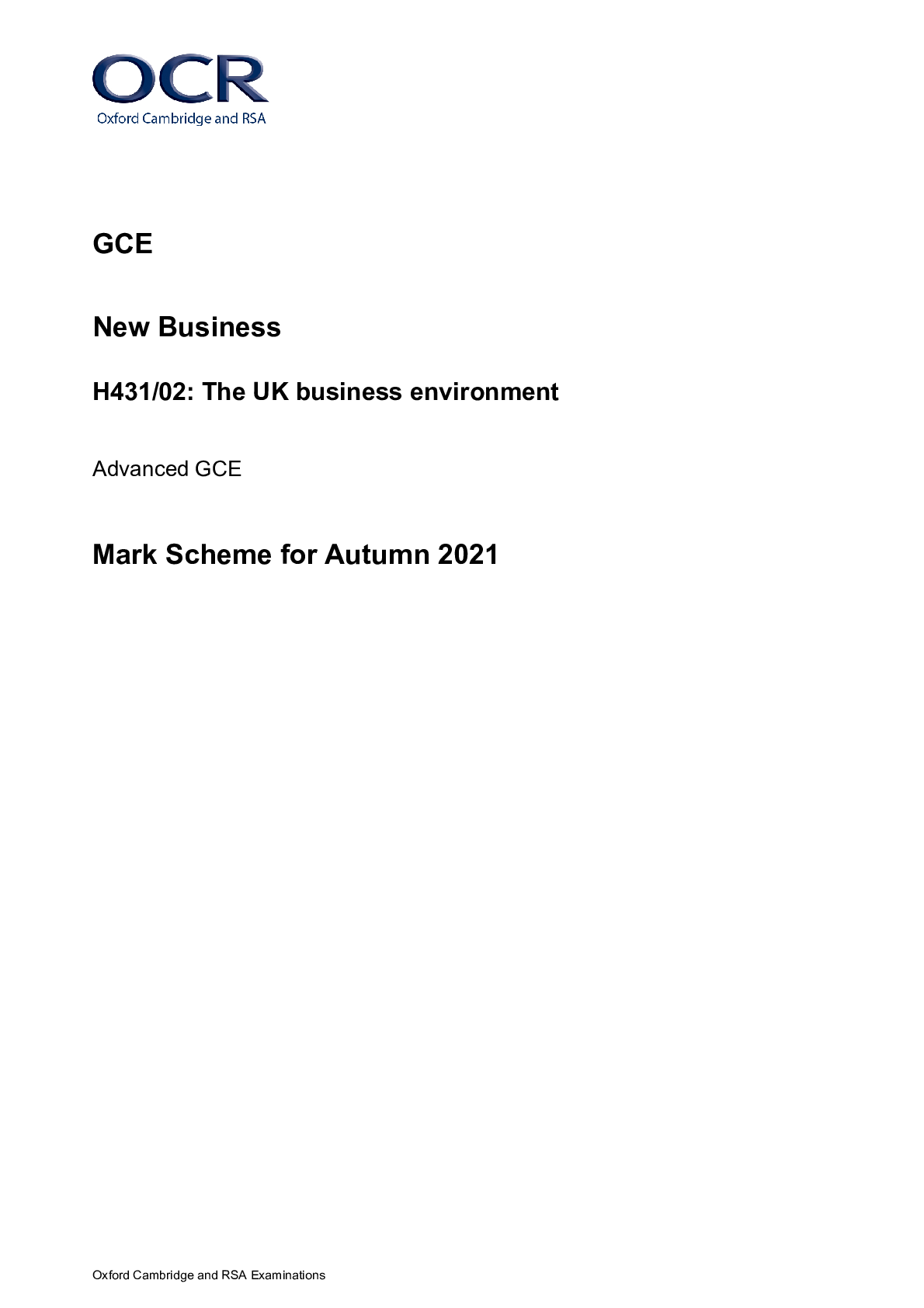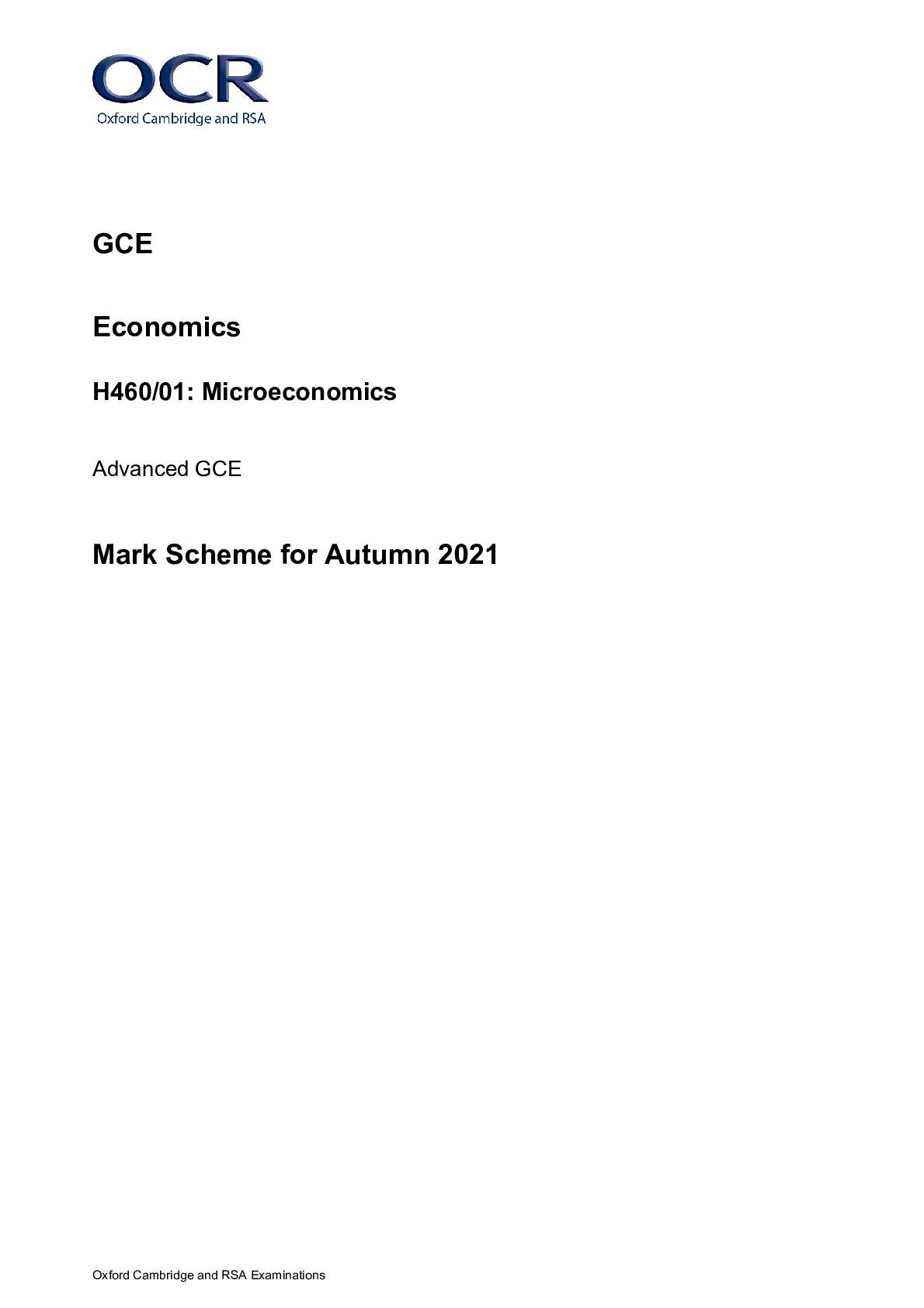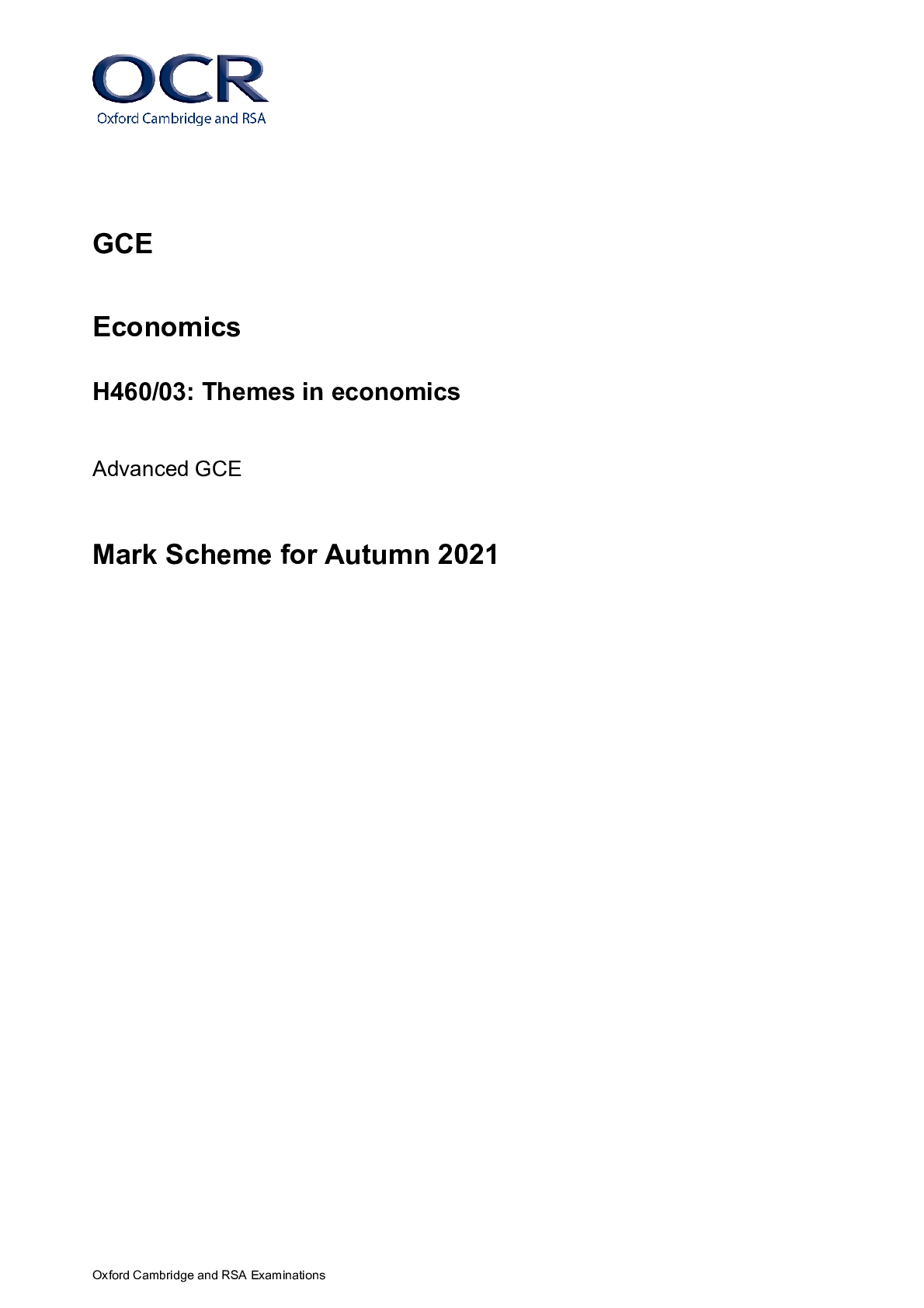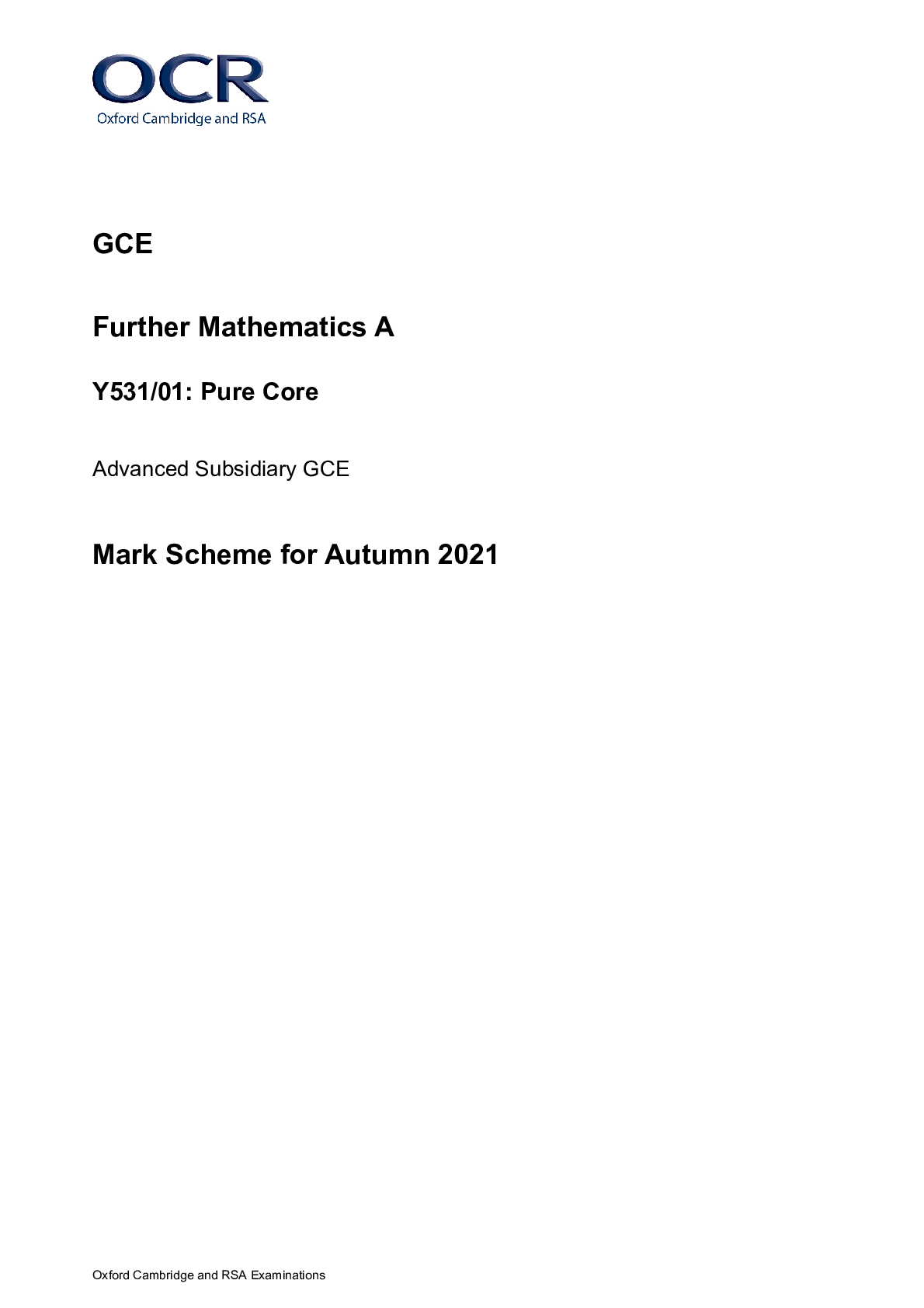Religious Studies > MARK SCHEME > GCE Religious Studies H573/02: Religion and ethics Advanced GCE Mark Scheme for November 2020 (All)
GCE Religious Studies H573/02: Religion and ethics Advanced GCE Mark Scheme for November 2020
Document Content and Description Below
GCE Religious Studies H573/02: Religion and ethics Advanced GCE Mark Scheme for November 2020 Oxford Cambridge and RSA Examinations GCE Religious Studies H573/02: Religion and ethics Advanc... ed GCE Mark Scheme for November 2020Oxford Cambridge and RSA Examinations OCR (Oxford Cambridge and RSA) is a leading UK awarding body, providing a wide range of qualifications to meet the needs of candidates of all ages and abilities. OCR qualifications include AS/A Levels, Diplomas, GCSEs, Cambridge Nationals, Cambridge Technicals, Functional Skills, Key Skills, Entry Level qualifications, NVQs and vocational qualifications in areas such as IT, business, languages, teaching/training, administration and secretarial skills. It is also responsible for developing new specifications to meet national requirements and the needs of students and teachers. OCR is a not-for-profit organisation; any surplus made is invested back into the establishment to help towards the development of qualifications and support, which keep pace with the changing needs of today’s society. This mark scheme is published as an aid to teachers and students, to indicate the requirements of the examination. It shows the basis on which marks were awarded by examiners. It does not indicate the details of the discussions which took place at an examiners’ meeting before marking commenced. All examiners are instructed that alternative correct answers and unexpected approaches in candidates’ scripts must be given marks that fairly reflect the relevant knowledge and skills demonstrated. Mark schemes should be read in conjunction with the published question papers and the report on the examination. © OCR 20202 Indicative content – Responses might include: Guidance 1. ‘Situation ethics provides the best approach to sexual ethics.’ Discuss. AO1 Candidates may demonstrate knowledge and understanding through the use of some of the following materials: • origins of agape in the New Testament and in the writings of Fletcher and how it might be applied in the area of sexual ethics (premarital sex, extramarital sex and homosexuality) • Fletcher’s six propositions and how they might be applied in the area of sexual ethics (premarital sex, extramarital sex and homosexuality): (1) love is the only thing which is intrinsically good (2) love is the ruling norm in moral decision-making and replaces all laws (3) love and justice are the same thing – justice is love which is distributed (4) love wills the neighbour’s good regardless of whether the neighbour is liked or not (5) love is the goal of the act and justifies any means to achieve that goal (6) love decides on each situation as it arises without a set of laws to guide it • Fletcher’s four working principles and how they might be applied in the area of sexual ethics (premarital sex, extramarital sex and homosexuality): (1) pragmatism – decisions based on experience rather than theory (2) relativism – decisions based on making the absolute laws of Christian ethics relative (3) positivism – decisions begin with belief in the reality and importance of love (4) personalism – decisions recognise that persons, not laws or anything else, are at the centre of this approach • Fletcher’s understanding of what conscience is and what it is not i.e. a verb not a noun; a term which describes attempts to make decisions creatively and how it might be applied in the area of sexual ethics (premarital sex, extramarital sex and homosexuality). AO2 Candidates may demonstrate evaluation and analysis through the use of some of the following arguments. • Some candidates might argue that the statement that situation ethics provides the best approach to sexual ethics (premarital sex, extramarital sex and homosexuality) is convincing because: o the concept of agape has sufficient depth and breadth to be understandable and widely applicable in dealing with the Candidates may compare situation ethics to other ethical theories and this is a valid approach.3 complexities of sexual ethics e.g. premarital sex and issues of consent and commitment o the use made by situation ethics of the six propositions and four working principles provides valuable and clear guidance in assessing issues of sexual ethics e.g. assessing the implications and consequences of extramarital sex o situation ethics has the strengths of a teleological ethical theory which rejects deontological and absolutist thinking e.g. any sexual act is good/bad/right/wrong dependent only on the consequences o sexual ethics has to adapt rapidly to the times and this is fully addressed by pragmatism, the first of the four working principles, whereby decisions are based on experience rather than theory e.g. changes over time regarding homosexuality and same-sex relationships o the focus of sexual ethics is on relationships and this is fully addressed by personalism, the fourth of the four working principles, whereby decisions recognise that persons, not laws or anything else, are at the centre e.g. rejects the objectification of the other person as a means of sexual gratification. • Some candidates might argue that the statement that situation ethics provides the best approach to sexual ethics (premarital sex, extramarital sex and homosexuality) is not convincing because: o agape, the key concept of situation ethics, is too vague and ill-defined to be of practical use in the area of sexual ethics o the focus of situation ethics in the first of the six propositions - that love is the only thing which is intrinsically good - can be misused and misapplied in the area of sexual ethics e.g. it allows for self-deception and exploitation o through its emphasis on pragmatism - the first of the four working principles - and relativism - the second of the four working principles - situation ethics is unable to provide clear guidelines as to what is good, bad, right or wrong in the area of sexual ethics e.g. it gives no guidance against abuse of power in sexual relationships o the religious aspect of situation ethics, whereby it is rooted in the Christian concept of agape, means that it cannot be the best approach to sexual ethics since it does not allow for entirely secular approaches o in comparison with the religious normative approach of natural law, the deontological normative approach of Kantian ethics or the teleological normative approach of utilitarianism, situation ethics is trumped as the best approach to sexual ethics. Some candidates may combine these views and argue that in certain aspects situation ethics provides the best approach to sexual ethics (premarital sex, extramarital sex and homosexuality) such as the focus on love and positivism, but in other areas such as its lack of clarity in terms of definition of agape, it is deficient.5 Indicative content – Responses might include: Guidance 2. To what extent do the weaknesses of natural law outweigh its strengths. AO1 Candidates may demonstrate knowledge and understanding through the use of some of the following materials: • Aquinas’ adoption and adaptation of Aristotle’s theory of natural law and his understanding of human telos being achieved by flourishing (eudaimonia) within the polis (community) • natural law seen in the context of the ordered universe governed by the four tiers of law: eternal, divine, natural and human • natural law understood as the light of reason placed within each person by God; as an orientation towards the good in human nature which is summed up by the key precept (do good and avoid evil) and five primary precepts (preservation of life, ordering of society, worship of God, education of children, and reproduction) • the primary precepts seen as being applied through the application of innumerable secondary precepts which are derived from them • moral acts resulting from the secondary precepts meeting the requirements of having a good intention resulting in a good exterior act • moral acts resulting from the secondary precepts meeting the requirements of being real goods (i.e. leading to flourishing) and not apparent goods (i.e. appearing to lead to flourishing but not doing so in reality). AO2 Candidates may demonstrate evaluation and analysis through the use of some of the following arguments. • Some candidates might argue that the weaknesses of natural law outweigh its strengths because: o natural law’s fundamental weakness is that it is based on the unprovable concept of telos which is artificially imposed on the universe and human life to provide order and design o natural law’s weakness is due to its dependence on the reliability of human reason whereas human reason is unreliable and imperfect o one of the main propositions of natural law - that human nature has an orientation towards the good - is based on weak foundations since it can be contradicted by empirical evidence o natural law shares the weaknesses of deontological and absolutist ethical theories since it cannot be adapted to changing times and changing circumstances o acceptance of natural law depends on an acceptance of its religious framework – such as eternal law and divine law – Candidates may describe Natural Law as both deontological and teleological – it has features of both. Eg) the doctrine of double effect6 Indicative content – Responses might include: Guidance which gives it a significant weakness in the face of secular thinking. • Some candidates might argue that the strengths of natural law outweigh its weaknesses because: o natural law’s concept of telos is a significant strength since it is based on common experience and on science o natural law’s reliance on human reason is a key strength since it grounds the theory in what is logical and rational o the primary precepts are part of the strengths of natural law since they promote the common good through the ordering of society and the education of children o natural law’s strength can be found in its adaptability through the use of secondary precepts and the doctrine of double effect o natural law shares the strengths of deontological and absolutist ethical theories since it can make clear statements about what is good, bad, right and wrong o the Doctrine of Double Effect enables followers of Natural Law to use reason to inform moral action. Some candidates may combine these views and argue that, for example, the weaknesses of natural law in certain areas such as the four tiers of law or the primary precept of worship God are balanced by its strengths in presenting what is overall a holistic and rational ethical approach.7 Indicative content – Responses might include: Guidance 3. ‘Good is best explained by emotivism.’ Discuss. AO1 Candidates may demonstrate knowledge and understanding through the use of some of the following materials: • naturalism (the belief that values can be defined in terms of some natural property in the world) and its application to the terms good, bad, right and wrong • the application of naturalism to absolutism • intuitionism (the belief that basic moral truths are indefinable but self-evident) and its application to the term good and by extension to the terms bad, right and wrong • emotivism (the belief that ethical terms evince approval or disapproval) and its application to the term good, bad, right and wrong • the application of emotivism to relativism. AO2 Candidates may demonstrate evaluation and analysis through the use of some of the following arguments. • Some candidates might argue that the statement that good is best explained by emotivism (the belief that ethical terms evince approval or disapproval) is convincing because: o the term good is entirely relative over time and place depending on the approval or disapproval given by an individual in each situation and circumstance o good does not refer to a natural property - which is evident in and of itself – but only displays an individual’s approval or disapproval o good as a descriptive term does not refer to something which is factual or which can be universally verified but rather to an individual’s approval or disapproval o the judgment that something is good varies from one person to another and is therefore all in the mind of the person making the judgment o good is no more than any other emotive term which reflects an individual’s approval or disapproval. • Some candidates might argue that the statement that good is best explained by emotivism (the belief that ethical terms evince approval or disapproval) is not convincing because: o the term good is absolute and universal in application regardless of the approval or disapproval given by an individual in each situation and circumstance o good refers to a natural property which is evident in and of itself and is therefore does not depend on an individual’s approval or disapproval o the term good has an objective basis which makes it true or false in describing something which is factual, which can be Candidates should be mindful that the question requires a focus on emotivism although reference to other theories may be used as a comparison8 Indicative content – Responses might include: Guidance universally verified and which does not depend on the approval or disapproval of an individual o from a common-sense perspective, all people share the same understanding of something being good which does not depend on the approval or disapproval of an individual o normative ethical theories such as natural law, situation ethics, Kantian ethics and utilitarianism are based on the belief that the term good does not depend on the approval or disapproval of an individual but can be applied to acts in themselves and can also be used in making judgments about consequences. • Some candidates may combine these views and argue that whilst in some cases good is best understood in a relativist sense reflecting the approval or disapproval of an individual, in other cases the term good reflects a common understanding across humanity over time and place.9 Indicative content – Responses might include: Guidance 4. Assess the view that Kantian ethics does not help with practical moral decision-making. AO1 Candidates may demonstrate knowledge and understanding through the use of some of the following materials: • Kantian ethics provides a deontological, objective and absolutist approach to moral decision-making which is based on reason • through reason, a person acts from duty – acting morally according to the good regardless of consequences • through reason, a person identifies the hypothetical imperative - a command to act to achieve a desired result – as not being the imperative of morality • through reason, a person identifies the categorical imperative - a command to act which is good in itself regardless of consequences • through reason Kant’s three formulations of the categorical imperative can be identified: o 1. Formula of the law of nature (whereby a maxim can be established as a universal law) o 2. Formula of the end in itself (whereby people are treated as ends in themselves and not means to an end) o 3. Formula of the kingdom of ends (whereby a society of rationality is established in which people treat each other as ends and not means). AO2 Candidates may demonstrate evaluation and analysis through the use of some of the following arguments. Candidates should focus on the application of Kantian Ethics to practical moral decisions in order to access higher levels10 Indicative content – Responses might include: Guidance • Some candidates might argue that Kantian ethics is of no help with regard to moral decision-making because: o Kantian ethics is absolutist and cannot adapt to changing times and circumstances which is what is required in practical moral decision-making o practical moral decision-making cannot be based simply on the extent to which duty is best served - which is what Kantian ethics requires o Kantian ethics is so reliant on reason that it rejects the importance of other factors such as sympathy, empathy and love which are essential in practical moral decision-making o it is too abstract in practical moral decision-making given its reliance on distinguishing between the hypothetical and categorical imperatives o Kantian ethics lacks any consideration of consequences which is what is required in all practical moral decisionmaking. • Some candidates might argue that Kantian ethics is of help with regard to moral decision-making because: o the dependence of Kantian ethics on reason gives it the clarity and coherence required in practical moral decisionmaking o duty is an essential part of practical moral decision-making because it is key in identifying what is good, bad, right and wrong o factors other than reason - such as sympathy, empathy and love – only confuse moral decision-making by making it biased and dependent on personal feeling o through the categorical imperative and its three formulations, Kantian ethics provides a framework which is both helpful and logical in practical moral decision-making o by being deontological, objective and absolutist in its approach to practical moral decision-making, Kantian ethics avoids reliance on unpredictable consequences. • Some candidates may combine these views and argue that whilst Kantian ethics is generally of no help in practical moral decisionmaking due to its abstract nature, key aspects of the theory such as the concept of duty can be helpful in determining whether actions are good, bad, right or wrong.1 Level (Mark) Levels of Response for A Level Religious Studies: Assessment Objective 1 (AO1) Demonstrate knowledge and understanding of religion and belief, including: • Religious, philosophical and/or ethical thought and teaching • Approaches to the study of religion and belief Note: The descriptors below must be considered in the context of all listed strands of Assessment Objectives 1 (AO1) and the indicative content in the mark scheme. 6 (14–16) An excellent demonstration of knowledge and understanding in response to the question: • fully comprehends the demands of, and focusses on, the question throughout • excellent selection of relevant material which is skillfully used • accurate and highly detailed knowledge which demonstrates deep understanding through a complex and nuanced approach to the material used • thorough, accurate and precise use of technical terms and vocabulary in context • extensive range of scholarly views, academic approaches, and/or sources of wisdom and authority are used to demonstrate knowledge and understanding 5 (11–13) A very good demonstration of knowledge and understanding in response to the question : • focuses on the precise question throughout • very good selection of relevant material which is used appropriately • accurate, and detailed knowledge which demonstrates very good understanding through either the breadth or depth of material used • accurate and appropriate use of technical terms and subject vocabulary. • a very good range of scholarly views, academic approaches, and/or sources of wisdom and authority are used to demonstrate knowledge and understanding 4 (8–10) A good demonstration of knowledge and understanding in response to the question: • addresses the question well • good selection of relevant material, used appropriately on the whole • mostly accurate knowledge which demonstrates good understanding of the material used, which should have reasonable amounts of depth or breadth • mostly accurate and appropriate use of technical terms and subject vocabulary. • a good range of scholarly views, academic approaches, and/or sources of wisdom and authority are used to demonstrate knowledge and understanding 3 (5–7) A satisfactory demonstration of knowledge and understanding in response to the question: • generally addresses the question • mostly sound selection of mostly relevant material • some accurate knowledge which demonstrates sound understanding through the material used, which might however be lacking in depth or breadth • generally appropriate use of technical terms and subject vocabulary. • A satisfactory range of scholarly views, academic approaches, and/or sources of wisdom and authority are used to demonstrate knowledge and understanding with only partial success 2 (3–4) A basic demonstration of knowledge and understanding in response to the question: • might address the general topic rather than the question directly • limited selection of partially relevant material • some accurate, but limited, knowledge which demonstrates partial understanding • some accurate, but limited, use of technical terms and appropriate subject vocabulary. • a limited range of scholarly views, academic approaches, and/or sources of wisdom and authority are used to demonstrate knowledge and understanding with little success 1 (1–2) A weak demonstration of knowledge and understanding in response to the question: • almost completely ignores the question • very little relevant material selected • knowledge very limited, demonstrating little understanding • very little use of technical terms or subject vocabulary. • very little or no use of scholarly views, academic approaches and/or sources of wisdom and authority to demonstrate knowledge and understanding 0 (0) No creditworthy response2 Level (Mark) Levels of Response for A Level Religious Studies: Assessment Objective 2 (AO2) Analyse and evaluate aspects of, and approaches to, religion and belief, including their significance, influence and study Note: The descriptors below must be considered in the context of all elements of Assessment Objective 2 (AO2) and the indicative content in the mark scheme. 6 (21–24) An excellent demonstration of analysis and evaluation in response to the question: • excellent, clear and successful argument • confident and insightful critical analysis and detailed evaluation of the issue • views skillfully and clearly stated, coherently developed and justified • answers the question set precisely throughout • thorough, accurate and precise use of technical terms and vocabulary in context • extensive range of scholarly views, academic approaches and sources of wisdom and authority used to support analysis and evaluation Assessment of Extended Response: There is an excellent line of reasoning, well-developed and sustained, which is coherent, relevant and logically structured. 5 (17–20) A very good demonstration of analysis and evaluation in response to the question: • clear argument which is mostly successful • successful and clear analysis and evaluation • views very well stated, coherently developed and justified • answers the question set competently • accurate and appropriate use of technical terms and subject vocabulary. • a very good range of scholarly views, academic approaches and sources of wisdom and authority used to support analysis and evaluation Assessment of Extended Response: There is a well–developed and sustained line of reasoning which is coherent, relevant and logically structured. 4 (13–16) A good demonstration of analysis and evaluation in response to the question: • argument is generally successful and clear • generally successful analysis and evaluation • views well stated, with some development and justification • answers the question set well • mostly accurate and appropriate use of technical terms and subject vocabulary. • a good range of scholarly views, academic approaches and sources of wisdom and authority are used to support analysis and evaluation Assessment of Extended Response: There is a well–developed line of reasoning which is clear, relevant and logically structured 3 (9–12) A satisfactory demonstration of analysis and/evaluation in response to the question: • some successful argument • partially successful analysis and evaluation • views asserted but often not fully justified • mostly answers the set question • generally appropriate use of technical terms and subject vocabulary. • a satisfactory range of scholarly views, academic approaches and sources of wisdom and authority are used to support analysis and evaluation with only partial success Assessment of Extended Response: There is a line of reasoning presented which is mostly relevant and which has some structure. 2 (5–8) A basic demonstration of analysis and evaluation in response to the question: • some argument attempted, not always successful • little successful analysis and evaluation • views asserted but with little justification • only partially answers the question • some accurate, but limited, use of technical terms and appropriate subject vocabulary. • a limited range of scholarly views, academic approaches and sources of wisdom and authority to support analysis and evaluation with little success Assessment of Extended Response: There is a line of reasoning which has some relevance and which is presented with limited structure. 1 (1–4) A weak demonstration of analysis and evaluation in response to the question: • very little argument attempted • very little successful analysis and evaluation • views asserted with very little justification • unsuccessful in answering the question3 • very little use of technical terms or subject vocabulary. • very little or no use of scholarly views, academic approaches and sources of wisdom and authority to support analysis and evaluation Assessment of Extended Response: The information is communicated in a basic/unstructured way. 0 (0) No creditworthy response1 Annotations Annotation Meaning Level one – to be used at the end of each part of the response in the margin. Level two – to be used at the end of each part of the response in the margin. Level three – to be used at the end of each part of the response in the margin. Level four – to be used at the end of each part of the response in the margin. Level five – to be used at the end of each part of the response in the margin. (H573 only) Level six - to be used at the end of each part of the response in the margin. Highlighting a section of the response that is irrelevant to the awarding of the mark. Point has been seen and noted, e.g. where part of an answer is at the end of the script. SUBJECT–SPECIFIC MARKING INSTRUCTIONS H173, H573 AS and A Level Religious Studies Introduction Your first task as an Examiner is to become thoroughly familiar with the material on which the examination depends. You should ensure that you have copies of these materials: • the specification, especially the assessment objectives • the question paper and its rubrics • the mark scheme. Please ask for help or guidance whenever you need it. Your first point of contact is your Team Leader. Information and instructions for examiners The practice scripts provide you with examples of the standard of each band. The marks awarded for these scripts will have been agreed by the Lead Marker and Team Leaders.2 The specific task-related indicative content for each question will help you to understand how the band descriptors may be applied. However, this indicative content does not constitute the mark scheme: it is material that candidates might use, grouped according to each assessment objective tested by the question. It is hoped that candidates will respond to questions in a variety of ways. Rigid demands for ‘what must be a good answer’ would lead to a distorted assessment. Candidates’ answers must be relevant to the question. Beware of prepared answers that do not show the candidate’s thought and which have not been adapted to the thrust of the question. Beware also of answers where candidates attempt to reproduce interpretations and concepts that they have been taught but have only partially understood. Using the Mark Scheme Please study the Mark Scheme carefully. The Mark Scheme is an integral part of the process that begins with the setting of the question paper and ends with the awarding of grades. Question papers and Mark Schemes are developed in association with each other so that issues of differentiation and positive achievement can be addressed from the very start. This Mark Scheme is a working document; it is not exhaustive; it does not provide ‘correct’ answers. The Mark Scheme can only provide ‘best guesses’ about how the question will work out, and it is subject to revision after we have looked at a wide range of scripts. Please read carefully all the scripts in your allocation and make every effort to look positively for achievement throughout the ability range. Always be prepared to use the full range of marks. The Mark Scheme contains a description of possible/content only; all legitimate answers and approaches must be credited appropriately. Learners are expected to make use of scholarly views, academic approaches and sources of wisdom and authority to support their argument. The Levels of Response must be used in conjunction with the outlined indicative content. Assessment Objectives Two Assessment Objectives are being assessed in all questions: AO1 (Demonstrate knowledge and understanding of religion and belief) and AO2 (Analyse and evaluate aspects of, and approaches to, religion and belief, including their significance, influence and study). Responses are credited for AO1 for selection, detail and accuracy of the knowledge and understanding of religion and belief deployed. Responses are credited for AO2 for how well the response addresses the question, for candidates using their knowledge and understanding to draw, express and support conclusions in relation to the question posed. Candidates will be assessed on the quality of the conclusions and points they argue and the clarity and success of their argument. Levels of Response Questions in this paper are marked using a levels of response grid. When using this grid examiners must use a best fit approach. Where there are both strengths and weaknesses in a particular response or particularly imbalanced responses in terms of the assessment objectives, examiners must carefully consider which level is the best fit for the performance. Note that candidates can achieve different levels in each assessment objective, for example a Level 3 for AO1, and a Level 2 for AO2.3 Please note that the Assessment Objectives being assessed are listed at the top of the mark scheme. Where a candidate does not address all of the Assessment Objective strands listed, the candidate cannot achieve the top level of response. Assessment of Extended Response The GCE General Conditions of Recognition state that: GCE 5.1 In designing and setting the assessments for a GCE qualification which it makes available, or proposes to make available, and awarding organization must ensure that, taken together, those assessments include questions or tasks which allow Learners to - a) provide extended responses As such, the quality of extended responses are assessed in all questions. While marks are not specifically given for this, descriptors for extended responses can be found in the AO2 Levels of Response in italics.OCR (Oxford Cambridge and RSA Examinations) The Triangle Building Shaftesbury Road Cambridge CB2 8EA [Show More]
Last updated: 1 year ago
Preview 1 out of 17 pages
Instant download

Buy this document to get the full access instantly
Instant Download Access after purchase
Add to cartInstant download
Reviews( 0 )
Document information
Connected school, study & course
About the document
Uploaded On
Oct 07, 2022
Number of pages
17
Written in
Additional information
This document has been written for:
Uploaded
Oct 07, 2022
Downloads
0
Views
38


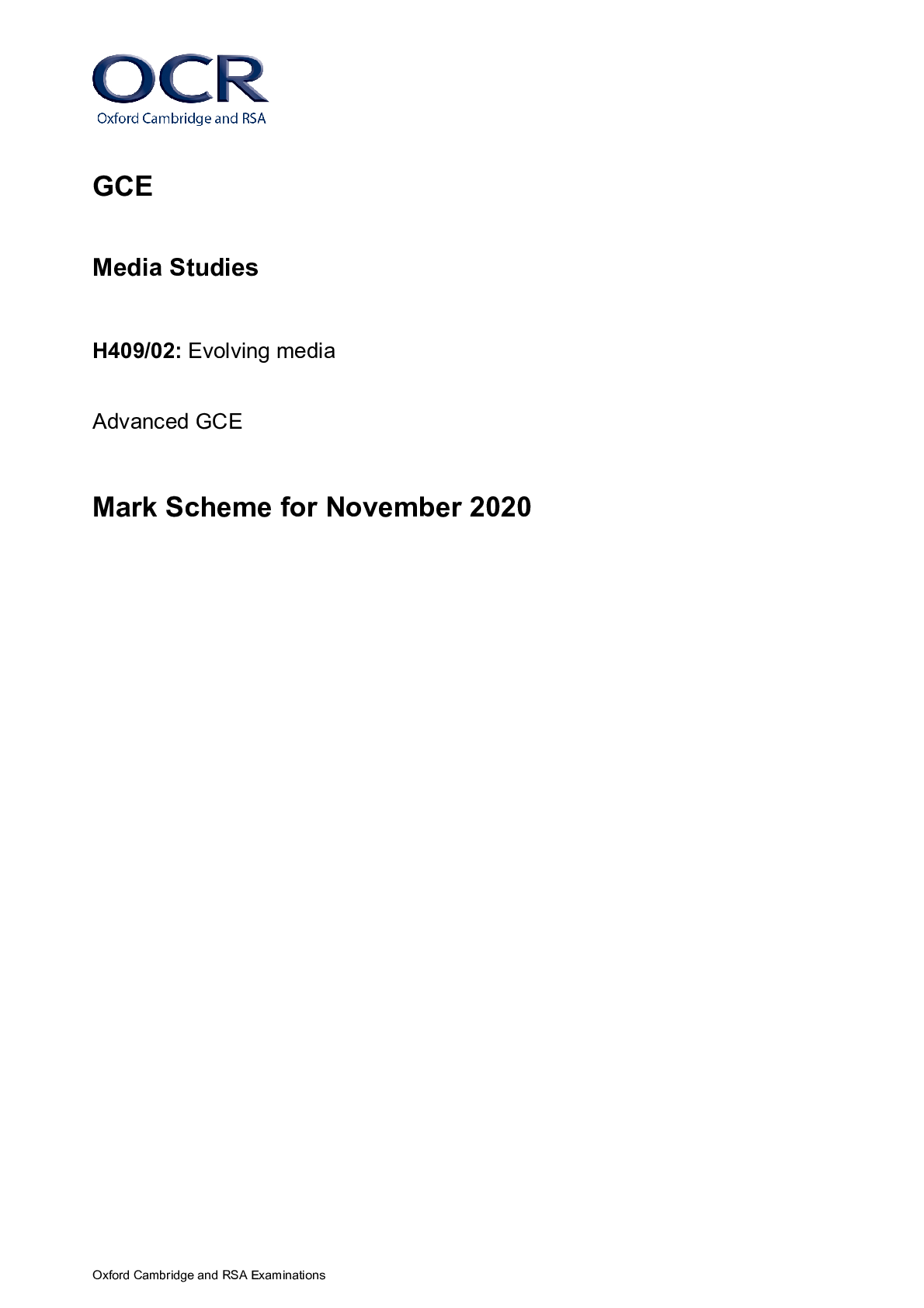
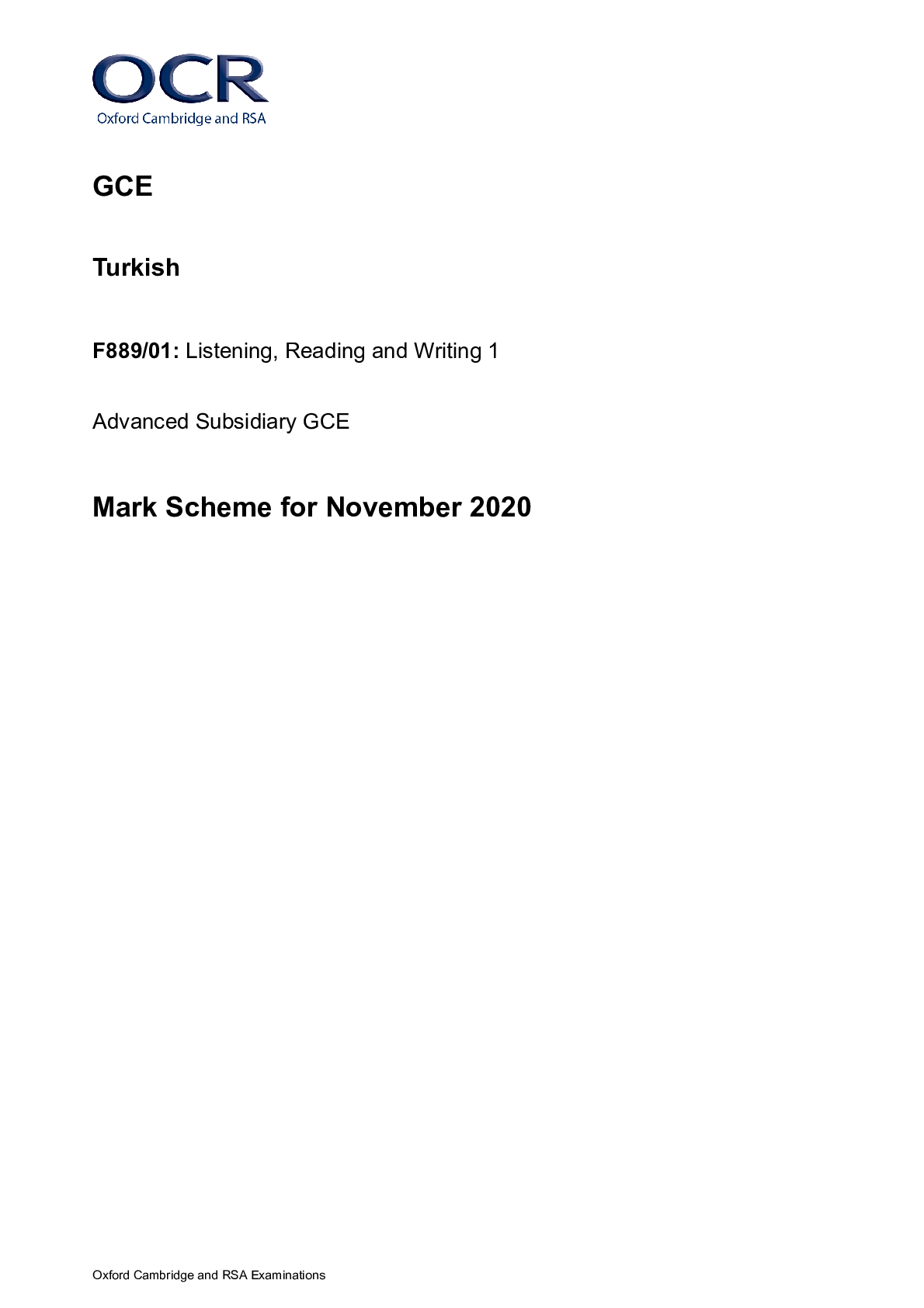
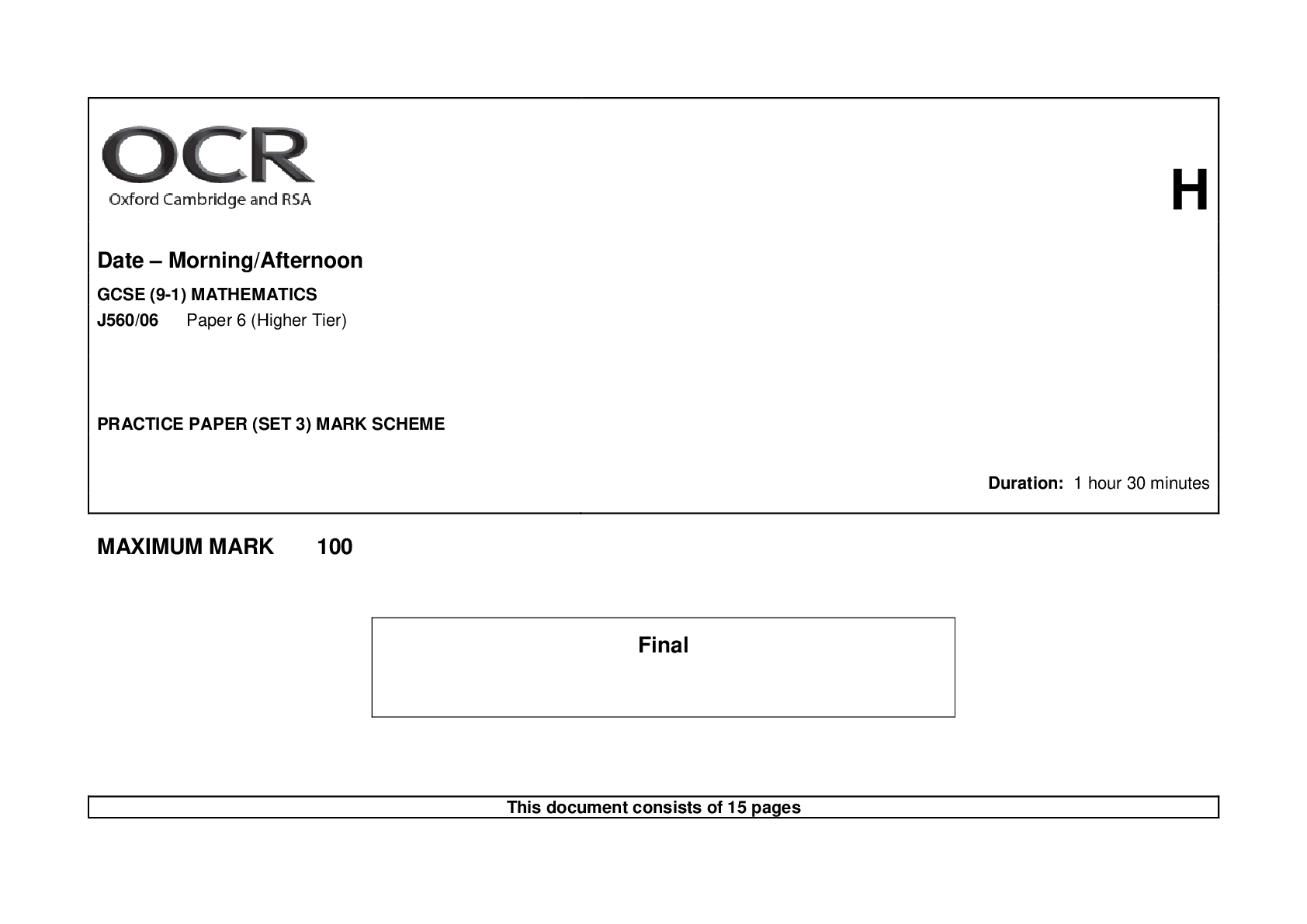



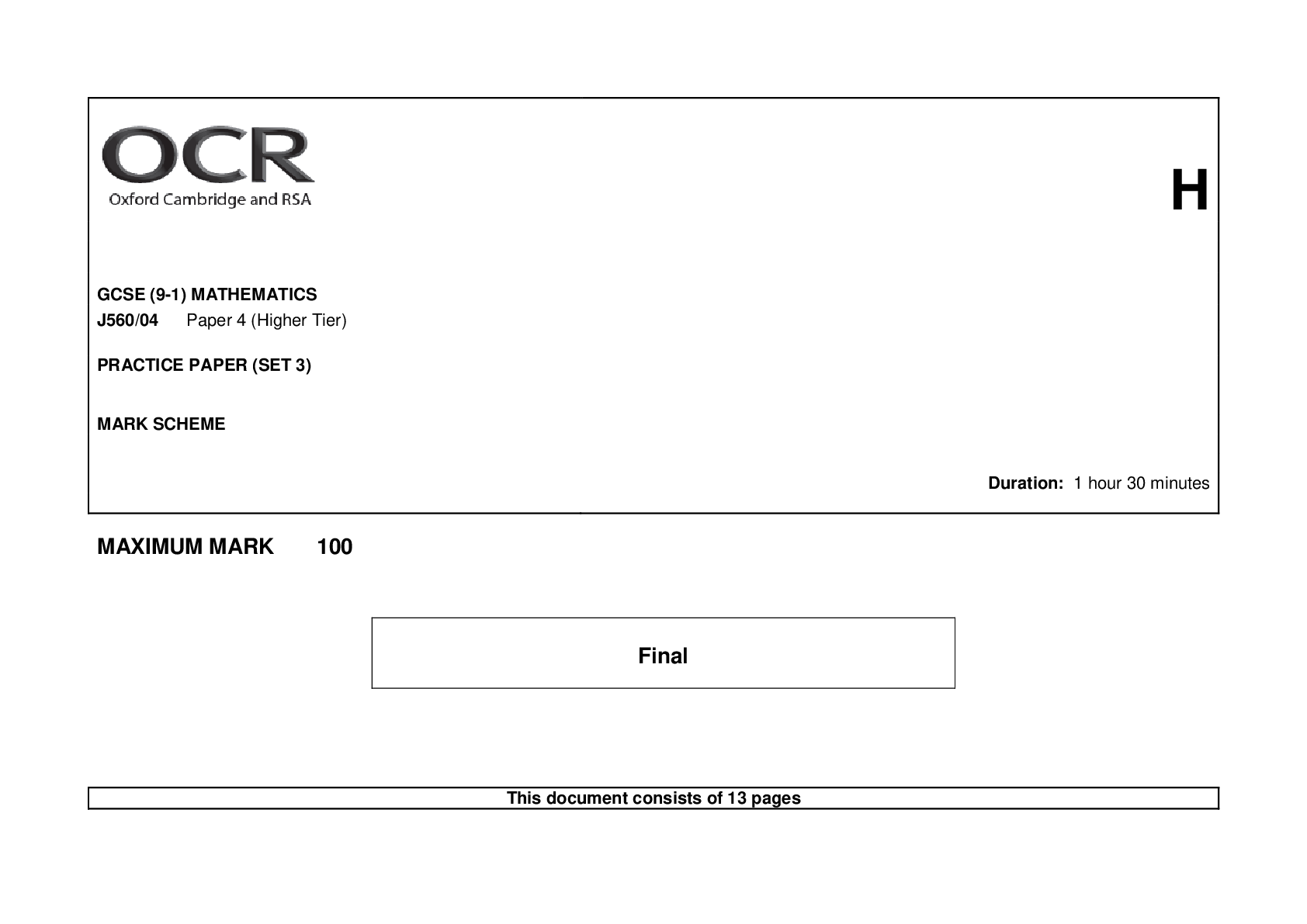



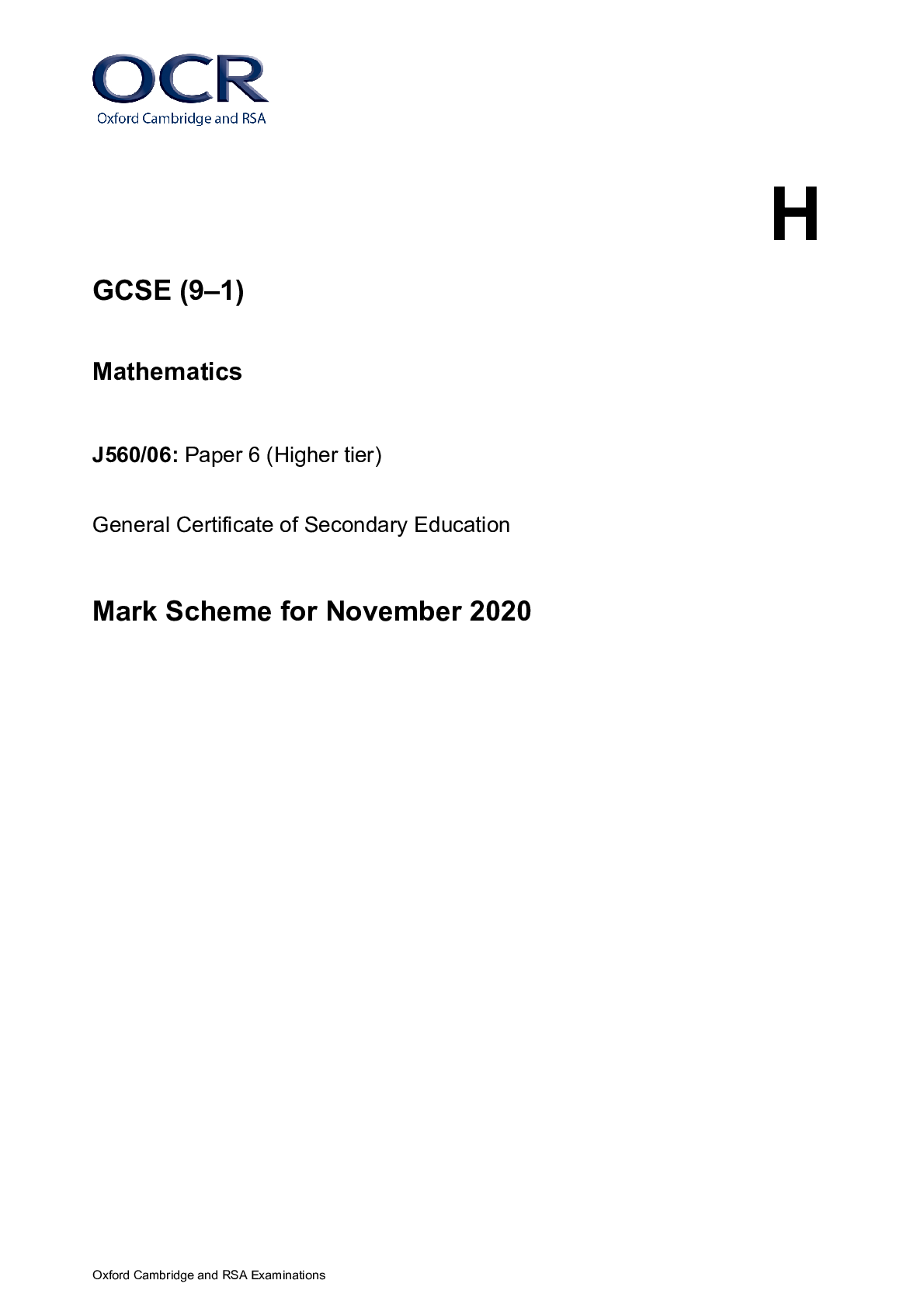
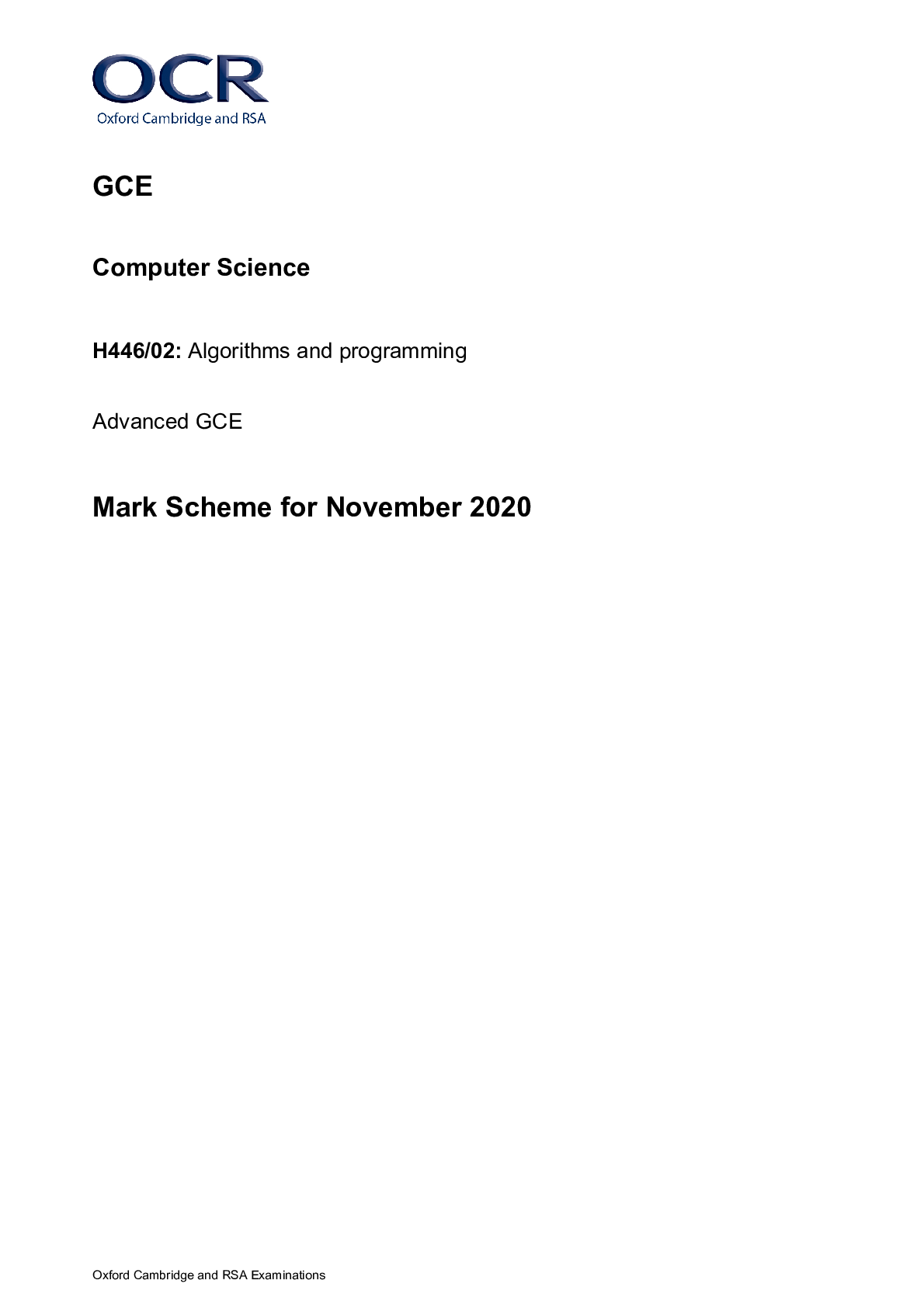
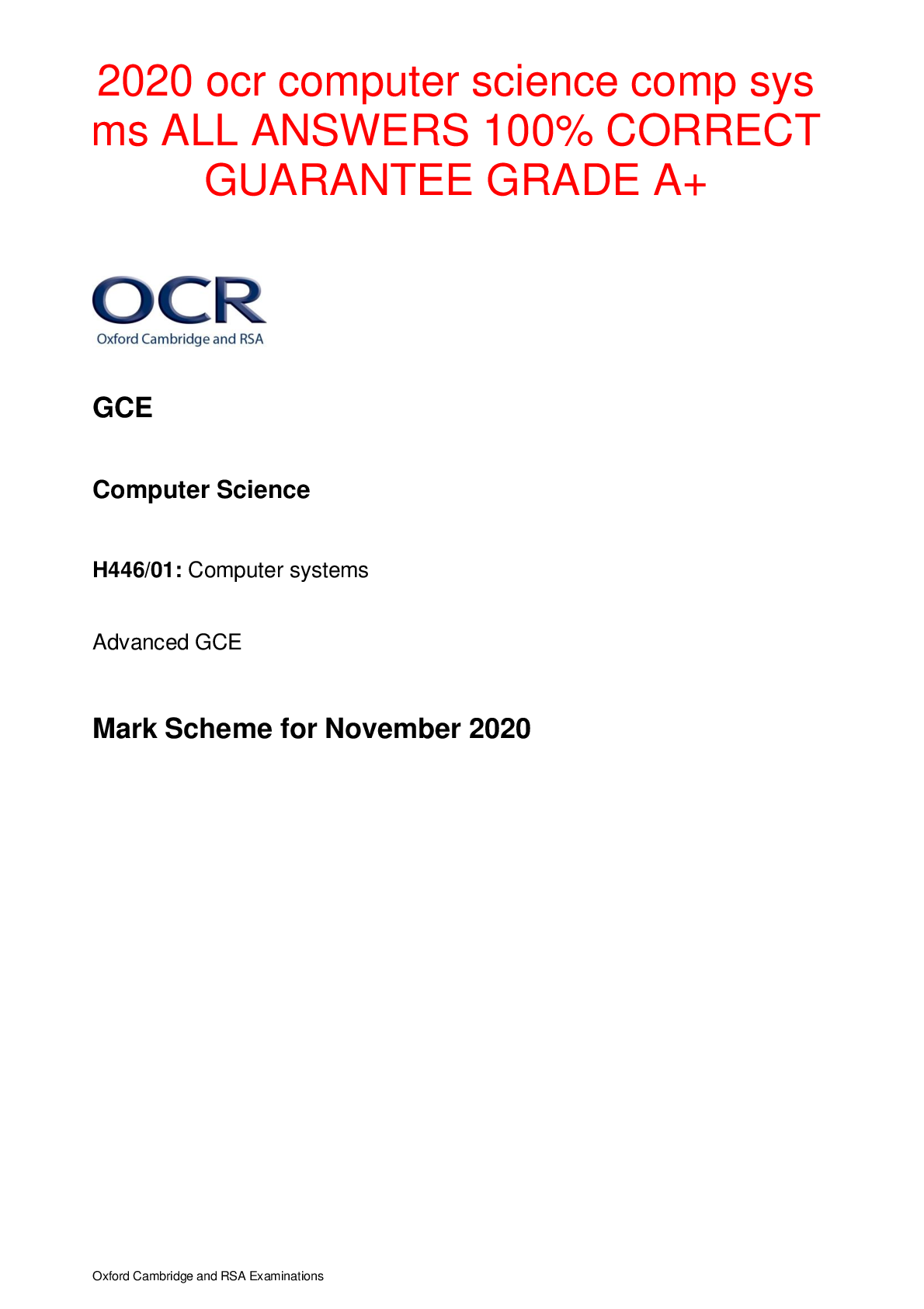

.png)
